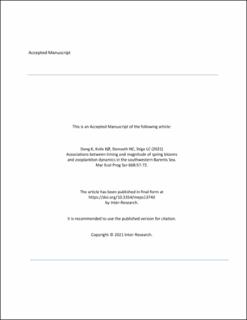| dc.contributor.author | Dong, Kaixing | |
| dc.contributor.author | Kvile, Kristina Øie | |
| dc.contributor.author | Stenseth, Nils C. | |
| dc.contributor.author | Stige, Leif C. | |
| dc.date.accessioned | 2021-10-06T09:11:42Z | |
| dc.date.available | 2021-10-06T09:11:42Z | |
| dc.date.created | 2021-09-23T09:08:54Z | |
| dc.date.issued | 2021 | |
| dc.identifier.citation | Marine Ecology Progress Series. 2021, 668, 57-72. | en_US |
| dc.identifier.issn | 0171-8630 | |
| dc.identifier.uri | https://hdl.handle.net/11250/2788045 | |
| dc.description | Embargo until 24 June 2022. | en_US |
| dc.description.abstract | During the past decades, many high-latitude marine systems have experienced a strong warming trend with poorly understood consequences for trophic coupling and ecosystem functioning. A key knowledge gap is how timing and magnitude of phytoplankton blooms influence higher trophic levels. We investigated associations between timing and magnitude of phytoplankton blooms and dynamics of 3 size fractions of mesozooplankton from 1998 to 2019. The study focused on the southwestern Barents Sea, an Arctic shelf sea area that is dominated by relatively warm Atlantic waters and which remains ice-free year-round. Results showed that an early spring bloom (late April to early May) was associated with high biomass of medium-sized (1-2 mm) zooplankton in areas ‘downstream’ of the phytoplankton bloom, along the prevailing currents. Conversely, a late spring bloom was associated with high biomass of small-sized (0.180-1 mm) zooplankton, with no spatial shift. High peak magnitude of the bloom (>5 mg chl a m-3) was associated with low zooplankton biomass, suggesting either top-down control or that the zooplankton utilized intense and presumably short blooms inefficiently. For small- and large-sized (>2 mm) zooplankton, the relationship was nonlinear, as zooplankton biomass was also low when bloom peak magnitude was very low (<4 mg chl a m-3). Our findings imply that if phytoplankton blooms in the region occur earlier, this will increase the biomass of medium-sized zooplankton that are important prey for planktivorous fishes. Moreover, our study highlights that increased biomass of phytoplankton does not necessarily translate into increased zooplankton biomass. | en_US |
| dc.language.iso | eng | en_US |
| dc.publisher | Inter Research | en_US |
| dc.title | Associations between timing and magnitude of spring blooms and zooplankton dynamics in the southwestern Barents Sea | en_US |
| dc.type | Peer reviewed | en_US |
| dc.type | Journal article | en_US |
| dc.description.version | acceptedVersion | en_US |
| dc.source.pagenumber | 57-72 | en_US |
| dc.source.volume | 668 | en_US |
| dc.source.journal | Marine Ecology Progress Series | en_US |
| dc.identifier.doi | 10.3354/meps13740 | |
| dc.identifier.cristin | 1937419 | |
| dc.relation.project | Norges forskningsråd: 280468 | en_US |
| dc.relation.project | VISTA: personal grant | en_US |
| cristin.ispublished | true | |
| cristin.fulltext | postprint | |
| cristin.qualitycode | 2 | |
